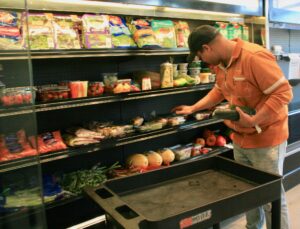
Brian Castellanos adds fresh vegetables to Good Grocer’s outlet, where food is available to buy at a significant discount.
BY STEPHANIE FOX
Last year, food insecurity in the Twin Cities increased substantially. Visits to the 472 food shelves rose from 300,000 to 500,000. The Minnesota Legislature passed a bill to provide $5 million in emergency funds, part of the Minnesota Emergency Food Assistance Program. The bill passed the House unanimously. In the state Senate, only seven members of the GOP delegation voted against it.
But many people are unable to access regular food shelves. For unhoused, disabled, or elderly people, among others, accessing a food shelf to collect boxes of food to take home and cook is difficult, if not impossible. For those people, there are options. Already-cooked meals are available free of charge through a number of organizations providing free meals to those who would otherwise go hungry.
Kitchen Coalition, part of Second Harvest Heartland, a leading hunger relief organization, provides prepared meals instead of groceries. They partner with nearly 20 restaurants, caterers and commercial kitchens, delivering prepared meals to nonprofit organizations that can offer take-away meals and street outreach delivery.
“Food insecurity has grown and there are three challenges as to why people need a prepared meal – housing, access to a place to cook and the physical ability to cook,” said Kitchen Coalition’s director Robin Manthie.
“General food insecurity is income and access-based,” she said. “We have street outreach to the unhoused, to mental health services, to daycare and youth programs where kids are responsible for cooking for themselves and, often, their siblings, if their parent is at work or not around for some reason. In the case of the unhoused, they don’t have a place to prepare meals. And then there are people in crisis.”
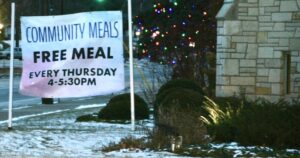
Mount Olivet Lutheran Church offers take-away hot meals each week.
“We have 100 different distribution partners distributing food between one and seven times a week,” Manthie said. “Some volunteers go to encampments, finding people near transit stations or under bridges.”
Some organizations prepare meals on site. Every Thursday, from 3:30 to 5:30 p.m., volunteers at Mount Olivet at 5025 Knox Ave. S., a Minneapolis church with the second largest Lutheran congregation in the country, distribute nearly 700 packages of prepared hot food. Cars line up starting at 3 p.m. A volunteer greets drivers and finds out how many meals are needed. When the car pulls up to the door, another volunteer delivers the order to those inside.
The church’s food ministry began serving food left over from funerals and other events inside the church, but with COVID, they were forced to switch to takeout meals. “That’s when we started becoming more popular,” said cook Kristi Grall. “Now we have pickup at the church, and we also deliver to people who can’t get out or drive around. We even do some delivery to street corners.”
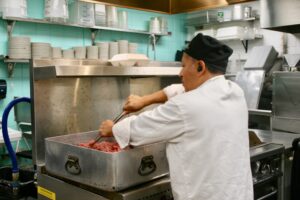
Chef Jose Llangari cooks more than 100 meals four times a week.
Grall now cooks meals specifically for distribution day. “We serve Minnesota comfort food,” she said.
One January portion gave people a choice between macaroni and cheese or a Thanksgiving casserole (turkey, stuffing, mashed potatoes and gravy). Packages also included a side of vegetables, a pasta salad, vegetable soup (a very popular item), a carton of milk or orange juice and a wrapped homemade cookie. Gluten-free options are also available.
Another food distribution site is Waite House, part of Pillsbury United Communities at 2323 11th Ave. S. There, Chef Jose Llangari prepares hot meals for at least 100 people every Monday through Thursday. The busiest days are produce days, every second and fourth Wednesdays, when boxes of fresh fruits and vegetables are available as well. That day’s meal, said Llangari, was chicken and mushroom primavera over bow tie pasta.
Until last month, Waite House was across the street from a large homeless encampment, which has since moved three blocks away. People from there, as well as others in the neighborhood and beyond, still show up from 11 a.m. to 12:30 p.m. for needed hot meals. No sign-up is required. People simply need to come to the 13th Avenue door for their grab-and-go bags. Plans are underway for the indoor café to open sometime in the next few months. When that happens, said volunteer Adrian, they will need more volunteers to help with the crowds, set up steam tables, and help with the cooking and serving.
Waite House limits the meals to three per person, but, Adrian said, “We have a couple of people we know well and know they need more. We know one person who lives in a sober home with five others and we let him take six meals.”
“We usually serve about 150 people a day, but things slowed because of the cold weather. We expect things will increase in the spring,” he said.
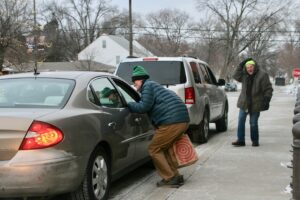
Volunteers deliver hot meals at Mount Olivet Lutheran Church.
Adrian said he volunteers as a way to get out every day, to talk to people. “COVID messed everything up. I lost people. Now I help people.”
On Eat Street, one grocery store is taking a drastically different approach to the hunger problem. They don’t provide ready-made hot meals, but while many grocery stores toss their almost-expired foods, the Good Grocer at 2650 Nicollet has a small food outlet located inside the store, offering 80% or more off the store price. The outlet is open to everyone.
The store also offers a 20% discount on non-outlet items for volunteers. Customers can buy fresh and frozen foods including fish and meat, fresh vegetables and fruit, even toiletries.
The store was originally opened in 2015 as a co-op by Kurt Vickman, the pastor of Upper Room, a local activist church, with
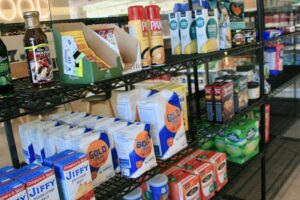
Good Grocer’s outlet is open to everyone
his wife Jeannette. When it started, it contained a free food shelf. But the Vickmans found that many people would offer small amounts of money instead of taking the food for free, hoping not to feel like charity cases. Because of a food shelf contract, the store couldn’t accept money, leading the couple to find a new way to help people who needed food assistance.
“When people are poor, others don’t look at them as being able to contribute. But here, people can feel proud instead of walking with their heads down into a place like a charity food shelf,” Vickman said.
While the store owners do not disparage the free food model for those who need it, their volunteers and customers are often working people with modest incomes who still struggle with food insecurity. For those people, a place like the Good Grocer is a welcome solution.
























